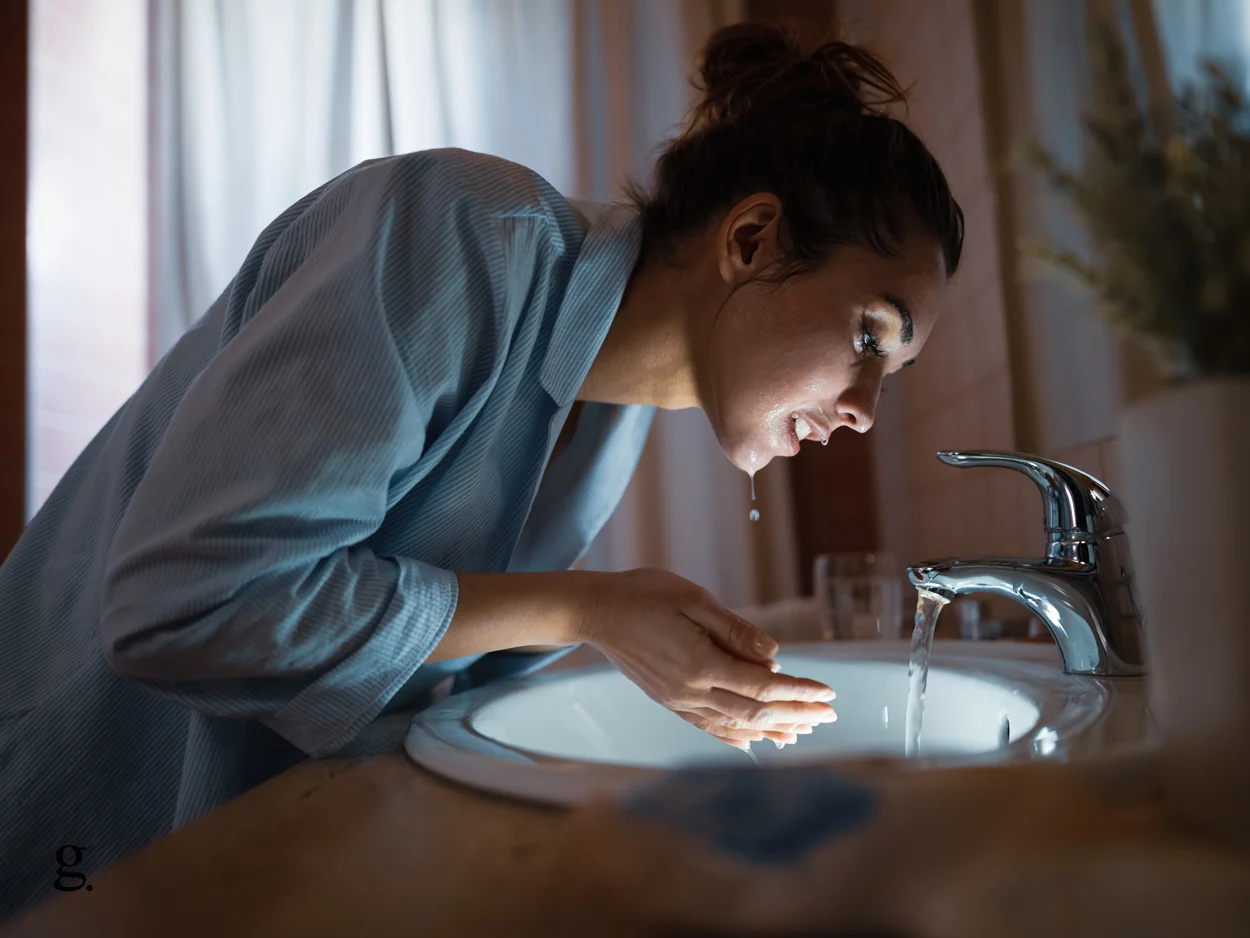While most people correctly assume that a skincare routine is done first thing in the morning, having a nighttime, or pre-bed, skincare routine is another way to massively benefit your skin – think of it as going the extra mile, for your skin’s sake!
Building a nighttime skincare routine can feel like a daunting task, especially with the plethora of products available on the market. But fear not, because creating the perfect regimen doesn’t have to be complicated. In fact, establishing a solid nighttime skincare routine can help you achieve that glowing, healthy complexion you’ve always wanted.
Below, we’ve listed what each step of your skincare routine should be, and what product(s) you’ll need for that step:
Step 1: Makeup Remover
The first step in your nighttime skincare routine should be removing any makeup you’ve applied. If you don’t wear makeup, then obviously skip this step completely, but if you do, it’s essential to invest in a high-quality makeup remover, as this step sets the foundation for the rest of your routine – don’t penny-pinch on this product!
There are various types of makeup removers available, such as micellar water, cleansing oils, and makeup wipes. Choose one based on your skin type and personal preferences:
- Micellar water: This gentle, no-rinse solution is suitable for all skin types, including sensitive skin. It contains tiny oil molecules called micelles that attract and lift away dirt, oil, and makeup without irritating.
- Cleansing oil: Oily and combination skin types may benefit from using a cleansing oil, as it can help dissolve stubborn makeup and break down excess sebum without stripping the skin of its natural moisture.
- Makeup wipes: While not the most environmentally friendly option, makeup wipes can be convenient for on-the-go situations. Look for alcohol-free and fragrance-free wipes to minimize the risk of irritation, especially if you have sensitive skin.
Step 2: Cleanser
After removing your makeup, it’s time to cleanse your skin to wash away any remaining impurities, dirt, and oil.
A cleanser is a skincare product designed to remove dirt, oil, dead skin cells, and other impurities from the surface of your skin. It helps maintain a clean and healthy complexion by preventing clogged pores, breakouts, and other skin issues.
Choosing the right cleanser for your skin type is essential for maintaining a healthy complexion and preventing any potential issues.
- Oily skin: Opt for a gel or foaming cleanser that can effectively remove excess oil without causing dryness. Look for ingredients like salicylic acid or tea tree oil, which can help keep breakouts at bay.
- Dry skin: Cream or lotion-based cleansers are ideal for dry skin, as they provide hydration while gently cleansing. Ingredients like hyaluronic acid and glycerin can help lock in moisture and prevent tightness after washing.
- Combination skin: A gentle, balancing cleanser that won’t strip natural oils or exacerbate dry patches is crucial for combination skin. Look for a formula that addresses both concerns without irritating.
- Sensitive skin: Fragrance-free, gentle cleansers without harsh chemicals or irritants are best for sensitive skin. Ingredients like chamomile and aloe vera can help soothe and calm any redness or inflammation.
Cleansers are an essential part of any skincare routine, as they create a clean canvas for the absorption of other products, ensuring their maximum effectiveness.
Step 3: Toner
Once your skin is cleansed, it’s time to apply a toner. A toner is a lightweight liquid that helps balance your skin’s pH, tighten pores, and remove any lingering traces of dirt or makeup.
To apply toner, dampen a cotton pad or ball and gently swipe it across your face and neck, avoiding the eye area. Allow the toner to dry and absorb into your skin before moving on to the next step.
Step 4: Treatments
This step isn’t necessary for everyone, but if you have specific skin goals or concerns, now is the time to apply targeted treatments. These specialized products can address issues like acne, hyperpigmentation, fine lines, or uneven texture. However, make sure not to double up on treatments if you’ve already used them in your daytime routine, as overusing certain active ingredients can lead to irritation or diminished results.
Commonly used nighttime treatments include:
- Serums: These lightweight, fast-absorbing liquids contain high concentrations of active ingredients and can target a wide range of concerns.
- Spot treatments: If you’re dealing with acne or occasional breakouts, a spot treatment can help. Products containing benzoyl peroxide or salicylic acid can be applied directly to blemishes to help reduce inflammation and speed up healing.
- Specialty masks: Masks or targeted treatments can address specific concerns like hydration, brightening, or pore refinement. These can be used once or twice a week, depending on your skin’s needs and tolerance.
When layering skincare treatments, start with the lightest, most watery products, and gradually move to the thicker ones, finishing with masks. Make sure you allow enough time for each product to absorb fully before applying the next, and be cautious when introducing new treatments by patch testing to ensure your skin’s tolerance.
Step 5: Night Cream
The final step in your nighttime skincare routine is to apply a moisturizer specifically designed for nighttime use – officially known in the skincare world as “night creams”.
It often has a richer, more nourishing texture compared to daytime moisturizers, which tend to be lighter and sometimes include sun protection. Night creams focus on providing hydration, repairing and rejuvenating the skin while you sleep, and taking advantage of the body’s natural repair process that occurs during rest.
This allows the skin to absorb and make the most of the active ingredients, providing your skin with essential nutrients and hydration while you sleep.
When selecting a night cream, look for ingredients that address your specific skin concerns. Some of the most beneficial ingredients we recommend looking out for include:
- Hyaluronic acid: This powerful humectant helps retain moisture in the skin, providing hydration and reducing the appearance of fine lines and wrinkles.
- Ceramides: These lipid molecules help strengthen the skin’s natural barrier, locking in moisture and protecting against environmental stressors.
- Retinol: A vitamin A derivative, retinol is known for its anti-aging properties, as it promotes cell turnover and collagen production, reducing the appearance of fine lines, wrinkles, and uneven skin tone.
- Niacinamide: This form of vitamin B3 helps reduce redness and inflammation, improves skin elasticity, and minimizes the appearance of pores.
- Peptides: These amino acid chains help stimulate collagen production, improving skin texture and firmness.
- Antioxidants: Ingredients like vitamins C and E, green tea, or resveratrol help neutralize free radicals, reducing signs of aging and protecting the skin from environmental damage.
What time should you start your nighttime skincare?
It should be noted that there is no right or wrong time to do nightly skincare, but generally speaking, you’re going to want to commence your nighttime routine directly before you go to bed and allow enough time for all the products to fully absorb before you go placing your head on your lovely clean pillows (which shouldn’t be any longer than 10-15 minutes).
We would personally recommend you start it approximately one hour before bed, but ultimately, choose a time that works best for your lifestyle and ensures consistency in your routine.
The Importance of Establishing Your Skin Type
Before diving into the world of nighttime skincare, it’s crucial to determine your skin type. Knowing whether you have oily, dry, combination, or sensitive skin will help you select the right products and make the most of your routine (we’ve written a whole article on how to identify your skin type).
Here’s a quick breakdown:
- Oily skin: If your skin appears shiny, especially in the T-zone (forehead, nose, and chin), and you’re prone to breakouts, you likely have oily skin. This skin type benefits from lightweight, oil-free products and gentle exfoliation to prevent clogged pores.
- Dry skin: Dry skin may feel tight and appear dull or flaky. It’s essential to use hydrating and moisturizing products to replenish lost moisture and protect the skin’s natural barrier.
- Combination skin: If you have a mix of oily and dry areas on your face, you probably have combination skin. Balance is key here – you’ll want to use products that address both oiliness and dryness without exacerbating either issue.
- Sensitive skin: Those with sensitive skin may experience redness, irritation, or discomfort from certain ingredients or products. Look for gentle, fragrance-free formulas designed specifically for sensitive skin to avoid irritation.
Once you’ve determined your skin type, you’ll be better equipped to create a customized nighttime skincare routine that addresses your unique needs.
Conclusion
Establishing a tailored nighttime skincare routine can significantly benefit your skin, providing it with the necessary care and nourishment during the night. By determining your skin type, selecting appropriate products, and following the steps outlined in this article, you’ll be well on your way to achieving a healthy, glowing complexion.
Remember to not double-up the usage of your treatments, that consistency is key, and adjust your routine as needed to best suit your skin’s requirements.
By investing time and effort into your nighttime skincare, you’re going the extra mile for your skin, and the results will speak for themselves.

